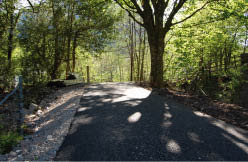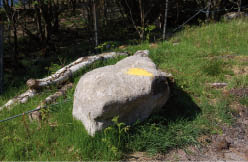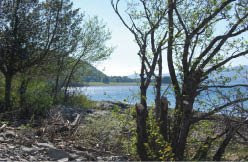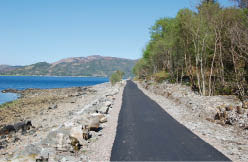Wednesday 18 June 2008
Abandoned Platform
With Oban 34 miles away you find an abandoned platform,
first thing you do is,
listen closely and you hear the wind,
whistling through the trees.
You start to wander round and notice that there are plants that have been uprooted and roots scattered about.
The presence of the people from the past lingers, yet you can still hear the cars driving up and down.
The further you go, the closer the trees get but then …they start to part and end up standing all alone with only the small things to keep them company.
QC Age 12
In the Bunker
In the bunker the water so deep
But be careful the witch will leap
As the trees weep
The tadpoles don’t make a peep
Before you know you’ll be down deep.
JM Age 10
Listen to the Wind
Listen to the wind
Blowing through the trees
Look at the insects
Crawling on the leaves
Watch the birds flying fast,
Hear the train going past
Use you imagination!
EM Age 10
Night of the Living Leaves
One day a vampire was walking along the abandoned platform and bit an oak tree.
From that day on every Saturday afternoon the leaves of that oak tree fall off and come to life then they suck your blood but after 5:00p.m. they cannot see the sun set.
So be careful you could be next.
I know of lots of people who went there at that time.
Down in the wood where the old station lies
where the wind and the rain makes the dead leaves fly.
AB Age 10
Rustling Through The Trees
Listen to the wind,
rustling through the trees
Look at the old station, covered with leaves
Can you see the witches house
Through the windows of the train
Or hear the sound of rain drops
Falling on the pane.
AH Age 12
The Scottish Express
Can you imagine the Scottish express coming up to the platform getting ready to rest.
The ground starts to rumble, the trees whistle away.
In the middle of the day the train decides to stay.
The Busy Platform at Night
It’s the middle of the night the sky is dark, but the platform is bright.
All the animals gather round to show things that they have found.
The badgers, hedgehogs and birds show there.
BM Age 11
The Bunker
Up from the platform past the birch trees
There lies a bunker as deep as can be,
Up the uneven craggy tree that leads to the bunker
There lies a dead witch inside dark and under.
Don’t get too close or you might not realise,
You were not meant to be there.
AM Age 12
The Railway Station
The Hustle and Bustle
The moving of people
The puffing of trains
The sunshine and rain
Why did it go away
So sudden so quickly
Now all that lies there is a rectory
Nature takes its hold many stories are untold.
BH Age 10
School Workshop by Norman Bissell (Ballachulish Primary School)
I met Carol in Oban and we agreed that our needs were rather different that day and hoped that it would clear up by the time we got there. On the way we stopped at shops and cafés to ask their owners to display posters inviting local people to take part in the cycle path project, which in one instance involved us trying to press A4 sheets on to a brick-hard, cluttered chipboard with the wind howling around us. The general response was very welcoming, although we were told that some landowners weren't keen on the path going through their land.
However, by the time we met Sam Clark and his P5, 6 and 7 pupils by the road that leads to Ballachulish Bridge, the rain had stopped and so we happily walked to the path and gathered together near the former station platform. I asked them what they could see, hear, smell, touch, taste and imagine all around them and to write down or draw some of those things, then we broke up into two groups, with Carol working with those who were drawing, while I helped those writing. At first it took them a little while to start writing poems and prose, but they soon got the hang of it and I read their work and suggested one or two ways they could improve what they had written. The sound of the wind in the trees and what it must have been like getting off the steam train at the station fired their young minds, and one of the pupils told us that his Gran used to collect tickets at Ballachulish station.
Sam discovered some traces of the station amongst the trees, pointed out how curved the platform was and explained that passengers would disembark there to go to the hotel and take the ferry across the narrows. Carol's group walked further along the path towards a cutting which went between rocks and came back with drawings of leaves, plants and the headless horseman who was supposed to have ridden the track that led to Ballachulish House. Halfway through we changed over groups and this time I took my group through the trees to explore a concrete block with a hole, pipes and some water in it that must have had something to do with the station.
It quickly became known as the witch's well and more poems and prose followed. In no time at all the minibus returned to collect them, so Carol and I went back to the school to tell the other pupils what we had done and to work for another half hour on their writing and drawings. Sam downloaded the photos he had taken on to his classroom computer to show everyone where we had been, and said he would work further with them on what they had done and perhaps take some to a coastal part of the cycle path near Kentallen.
That part of the path has magnificent open views of Morvern and some of the boulders along it might be suitable for carving short poems on before reaching a possible stopping place where cyclists could sit on a large rock-shelf on the shore and enjoy the seascape. Here are a few more lines about the path:
Winding through woods
on the trail
of the ghost train.
Wind blows
whin grows
wind whispers
birch shivers
wind calls
leaf falls.
Friday 13 June 2008
My favourite UK Television Adverts, Download & watch them here FREE. Find out the music they have used in them.
My favourite UK Television Adverts, Download & watch them here FREE. Find out the music they have used in them.
Thursday 12 June 2008
So What Ever Happened to that Hole in the Ozone Layer? - Environment
So What Ever Happened to that Hole in the Ozone Layer? - Environment
Friday 6 June 2008
Oban to Fort William Cycle Path Pictures
My Job
Oban to Fort William Cycle Path Ideas from Website
Seats along the way which might include a shelter and interpretation.
Artworks that are functional.
Maybe business could be paid a small fee to allow path users to use the toilets on their premises - I believe that this is being trialled eslewhere.
Oban to Fort William Cycle Path School Workshop
It went very well, on Monday, Birgit and I stopped at the Castle Stalker Cafe and at Glenachulish on the way to the school and had a good 45 minute session with Sam Clark and a full class of P5, 6 and 7 pupils who seemed keen and soon got the idea. I've arranged to meet Sam and 12 pupils in total (drawn from each age group) on Monday at 1.30 pm on the path near the entrance to the Ballachulish Bridge.
Near or at the platform would be one possibility for seating, signage etc., although the traffic going on to the Bridge is quite noisy there. Further back along the path by the small bridge over the river would be better sound-wise but would probably be too close for access to the houses by the golf course. If we can get a look on Monday at the path further back by the lochside towards the Holly Tree, perhaps that would be a place cyclists and walkers would rather stop with more open views? I'll email Sam and see if it would also be possible for us to go along there after writing and drawing at the platform area.
Another possible title for the route I came up with is The Birlinn Way which would relate both to the Highland galleys which used to go up that coast and to the Scots word birl for going round, like the wheels of a bike. Let's go for a birl on the Birlinn Way! It would also fit in well with the idea of upright paddles for signage. Sam and the kids seemed to like the suggestion of possibly naming parts of the route within the overall name, which would give travellers a sense of the changing areas they're passing through. What do you think?
Anyway, here are some short poems I wrote about that part of the path which I'll also send to Sam to give him and the pupils further food for thought.
Oban to Fort William Cycle Path Poem
Deep in the woods
a long, black path
that leads to the narrows.
Following the coast
between granite cuttings
echoes of a railway line.
A deserted platform
amongst birch and hawthorn
last stop Ballachulish.
Norman Bissell
Oban to Fort William Cycle Path Brand names
- The Birlinn Way
- The West Coast Trail
- The Atlantic Way
- The Lorne to Linnhe Trail
- The Coastal Trail
- The Atlantic Trail
- The Coastline Trail
- The Longshore Path
- The Shoreline Trail
- Tracing the Coast
Oban to Fort William Cycle Path Introduction
This handbook is not an exhaustive study on tourism/visitor trends, populations and socio-economic trends of the area. Our intention is to provide a resource of ideas, methods and possibilities to the development of the Oban to Fort William Cycleway.
We will exploring local communities along the way, examining ideas and landscapes and providing a map of artists and expertise, concepts and designs that will illustrate the “Big Idea” behind the Path.
First Steps
The first scoping trip took place in a stormy February 2008. This trip was made on a bike and using trains fro Newcastle to Fort William and returning From Oban to Newcastle.
Part of the purpose behind the visit was to meet with Scottish Natural Heritage in Fort William to discuss another project I was working on in Glen Roy. During the discussions it became evident that the recently designated Geo Park status given to Glen Roy was an important new element alongside the existing National Nature Reserve.
It was important for a number of reasons:
- It brought Geology to the forefront
- Geology shapes the landscape
- Geology affects communities
- Geology creates communities
- Geology can provide a link
The Fort William area with the nearby super volcano of Glen Coe Provides a rich mix of different landscapes and economies from coal to aluminium. There are small pockets of individual distinctiveness along the short distance including deposits of Garnets. This theme of geology is one of those happy coincidences as even as early as the tender stage I felt that Geology could provide a “signature brand” for the naming of the path.
During that same visit I also met with a local artist and proprietor of the Lime Tree Gallery and restaurant, Dave Wilson. He and I had a long discussion about the artistic possibilities that the path could provide and geology was once again a strong theme.
Dave had worked with a local school, where they had constructed the two pillars wither side of the steps to the entrance to the gallery and restaurant.
These pillars used layers of different stone, including sandstone, quartz, glass and aluminium ingots made in the Fort William Smelter. In the middle of the layers, the children had placed images, drawings, shells etc. In a way they had created a vertical timeline. He, along with the SNH-Fort William people are also keen cyclists and so the notion of a Geo-Path was cemented in my mind.
The Brand - Option 1
In first considering the management plan I felt it was important to look for the “big idea”. This has developed into an interconnected theme of “geology – journeys – stories”. I have felt from the beginning that there was an opportunity to tell a story through poetry.
The brand “Geo-Path – Journeys through time and place” is proposed to tell the tale of landscape – people – history. The idea stems from the designation of the Geo Park in Fort William. This has been extended to bring to life the landscape and how it has shaped the commerce, history and wildlife over the years. So from early history we have the story of the Birlinn or Highland Galley and its role in combating the Vikings. The Birlinn due it having a fixed rudder was able to manoeuvre through the inlets and lochs of the west coast. They basically fought a skirmish war with hidden caches of weapons and food on islands, so they could quickly make base, pick up supplies and then be off again.
So the Geo-Path allows us to create a journey along the coast between Oban and Fort William using the Access Controls and interpretation/seating as mechanisms for this idea.
The access control post (gift posts) is in the shape of the prow of the Galley with slots/holes in to allow visitors to put items of interest into them (cache). Should you like something you find in the gift posts then you can take it as long as you replace it with something you have found yourself. This is coupled with a story gate. This gate is a canvas for telling stories. The idea is to take a workshop to schools and work with the children on creating “story fish”. These fish can then be taken and made into metal plaques for attaching to the gates.
Oban to Fort William Cycle Path
Community Consultation
Posters and ideas box to be placed in libraries, community centres, shops, etc. These will allow people to get a feel for the project and contribute ideas.
At this stage we are looking for the following to come from it:
- Ask for the public to come up with a name (or choose from a selection of names)
- Create a database of artists and craftspeople who might want to help with structures
- Ask for opinions on the types of structures they would like to see:
- Artworks
- Seating
- Interpretation panels
- Signage
- Shelters
- Contact community councils
- Contact local interest groups such as:
- History societieso Wildlife societies
- Bike and commuter groups
- School groups
- Disability groups
- Geology groups
- Local commerce and businesses
- We intend to create some posters and flyers along with a form and a box so that people can tick boxes and voice opinions and place them in a box for us to collect
- We will be putting some information Differentia.co.uk for people to read and comment on via a guestbook.
- We would like to put together a bank of sample interpretation panels/artworks/seating/shelters for people to see and comment on.
- We need a simple map showing the timetable of completion for the path itself.
- We need a more detailed map showing the locations of possible signage/access controls/interpretation/seating etc.
- We will be compiling a list of everyone who will be contributing to the interpretation
- We will be suggesting some ideas for events including the run/kayak/cycle event mentioned at the meeting
- We will look at the possibility of producing interpretation panels at key locations that can be produced and updated easily by local groups.
- We would like to create some poetry and words for use on the signage (Jeremy’s paddles) so if we can some drawings of the signage from Jeremy to show the school what we are intending that would be very helpful.






